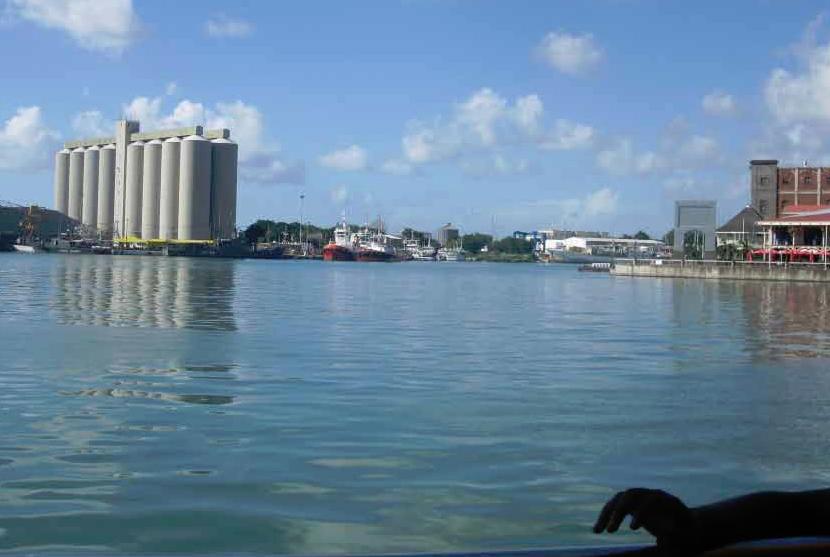
The achievements of the Mauritius Ports Authority (MPA) over the past decade have transformed Port Louis Harbour into a world class shipping facility. Jayne Alverca reports.
The Indian Ocean may be the stuff of dreams for tourists, but the authorities who manage Port Louis Harbour in Mauritius have more serious concerns to contend with. As an island state, the port’s management play a pivotal role in the Mauritian national economy, as it represents the main link with the external world for almost all transportation requirements.
The port itself consists of three main terminals which house a total of 14 separate quays. Together, these facilities handle about 99 per cent of the total volume of external trade and contribute more than two per cent to the country’s GDP. All strategic imports such as foodstuffs, petroleum products and raw materials for the textile industry must also rely on the port as a transit point.
By the turn of the millennium, two decades of heady growth and constant expansion had near exhausted the port’s capacity. During 2002, a new vision and a new strategic plan were formulated to modernise the port’s infrastructure and facilities and create the extra capacity needed to meet the demands of the fast expanding maritime trade, in particular the deep berth requirements of a fifth generation of super large container ships.
Over the past decade, the port sector has undergone major reforms and has been transformed into an economic nerve centre equipped with modern port facilities offering world class port services. A key improvement has been the dredging of the access channel to the Mauritius Container Terminal to provide additional draft. This means that fifth generation vessels can now use the port’s facilities. The size of the container yard has been almost doubled to give a storage capacity of 550,000 TEUs and the existing container berth was expanded by an additional 150 metres so it could accommodate three container ships at any one time.
Because the Indian Ocean can be subject to devastating cyclones, the Mauritius Container Terminal had experienced recurrent floodings due to prevailing swell conditions. On occasion, this had caused major disruption to operations at the terminal. To prevent the flooding problem, MPA is now proceeding with the construction of a concrete wall along the length of the terminal and will rehabilitate the rock revetments located to the north and south. The work is being carried out a cost of Rs 100 million and is now nearing completion.
A new radio station, which became operational in April 2008, is equipped with radars, modern radio/communication and a vessel tracking system to provide an improved maritime service and ensure navigational safety for the port’s growing volume of traffic.
There is also a new oil jetty which has been built at Mer Rouge at a cost of Rs 623 million to improve the unloading of petroleum tankers. In a handling operation that now meets world class standards of safety and efficiency, Port Louis Harbour handles well over a million tonnes of petroleum products each year. These comprise many toxic and highly flammable substances such as motor gasoline, gas oil and jet aviation fuel as well as standard fuel oil and liquefied petroleum gas (LPG). Petroleum products were previously unloaded at a series of different locations in the inner harbour which had negative cost, time and particularly safety implications as storage tanks were in close proximity to a residential area and potentially posed a major health and safety hazard.
This problem has now been solved and with an increased alongside depth of -14.5 metres, the berthing of bigger tankers of up to 50,000 DWT is now also possible. The new oil jetty has a total throughput capacity of about four million tonnes per annum and has been built to meet requirements for many years to come
In another ambitious move, MPA has embarked on a project for the construction of a dedicated cruise jetty at Les Salines. At a total project cost of about Rs. 485 million, this has enabled the port to cater for larger cruise vessels and also facilitated improvements to passenger comfort, transfer and safety. The contract for the construction of the jetty was entrusted to Messrs Afcons (India) in November 2008 and was officially inaugurated on 15 February 2010.
The move will provide the national economy with a major boost to tourism revenues by supporting a strategy that will see Port Louis Harbour acquire ‘home-port’ status for cruise tourism. During the last financial year, cruise traffic grew by almost 60 per cent with 22 passenger vessels calling in to the port. The ability to handle bigger vessels means that passenger numbers increased even more, growing by a record 105 per cent in a single year.
MPA is proud of its achievements to date, but the work to maintain the port’s newly won world class status is ongoing. Forecasts claim that container traffic will double by 2015 and major shipping lines have made plain their intention to use larger container vessels in the area. In response, the size of the container berth is set to increase again and further deepening of the channel that gives access to the container terminal is also planned. The next project, due for completion in 2013, will include measures that will see the berth at the container yard extended by another 150 metres and able to accommodate ships with a draft of 16.5 metres.
Meanwhile the reclaimed land of Les Salines at the southern edge of the port is the proposed site of a major waterfront development project which will provide a marina, top quality hotels and a wide spectrum of leisure and toursim facilities. This will complement the cruise ship facilities already in place and provide a major impetus to the nation’s emerging tourism industry. The project will be executed in three phases and will take at least 10 years to execute.



 MauritiusPORT_APR_11_emea_BROCH_s.pdf
MauritiusPORT_APR_11_emea_BROCH_s.pdf









